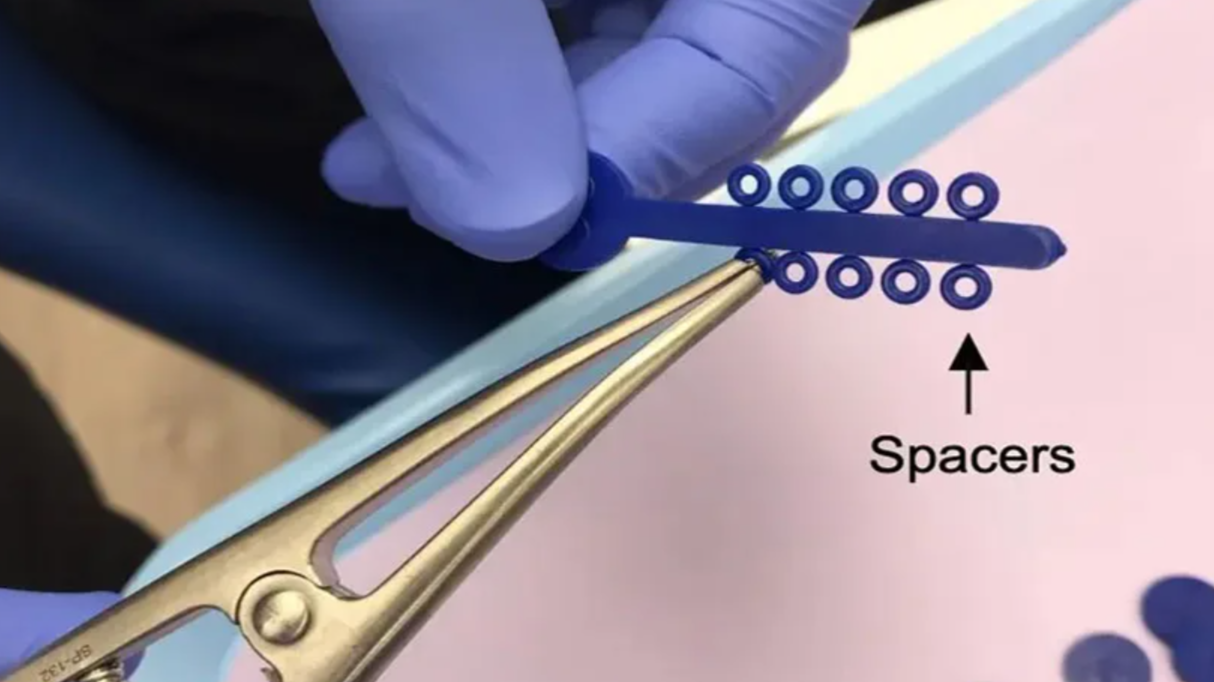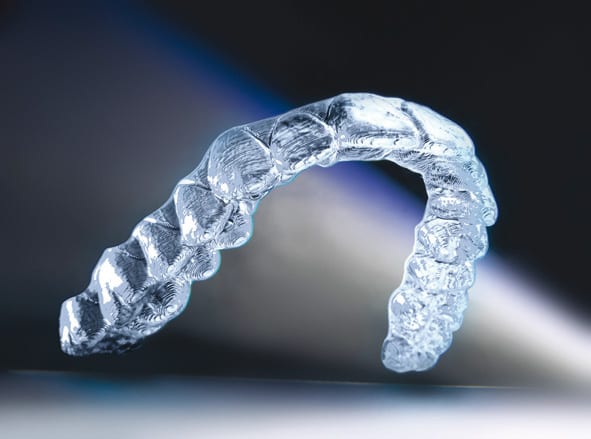Orthodontic spacers, also known as separators, are small devices placed between the back teeth to create space for metal bands used in braces treatment. Typically used during the early phase of orthodontic care, spacers help prepare the teeth for band placement—an essential step for anchoring the archwire and ensuring proper tooth alignment. Worn for about 1 to 2 weeks, these devices apply gentle pressure that gradually moves the teeth apart. While not required for every patient, spacers are a critical tool for achieving optimal treatment outcomes when bands are needed. Understanding their role can help patients better navigate the initial stages of their braces journey.
Table of contents
What are the different types of spacers?
What do rubber spacers do?
Rubber spacers are small, elastic loops—usually blue—that orthodontists place between two back teeth. These spacers apply continuous, gentle pressure to gradually create space for metal bands that will anchor the braces archwire. They are the most commonly used type of spacer in modern orthodontics due to their flexibility and ease of placement. For most patients, rubber spacers are worn for 1 to 2 weeks before band placement.
Key details about rubber spacers include:
Small blue elastic loops placed between back teeth
Gradually push teeth apart to create space for bands
Typically worn for 1-2 weeks prior to band placement
Most commonly used spacer type in modern braces treatment
What is a metal spacer used for?
Metal spacers
Metal spacers—small metal rings—serve the same purpose as rubber spacers by creating room between the back teeth. They are generally used when a patient’s teeth are especially tight or when more robust separating force is needed. Metal spacers can be more effective in cases where rubber spacers might slip out prematurely or fail to create enough space.

How long do metal spacers stay on?
Like rubber spacers, metal spacers are typically worn for about 1 to 2 weeks. However, the duration may vary depending on how much space is needed and the patient’s individual tooth movement. In rare cases where more significant spacing is required, metal spacers may remain in place slightly longer. The orthodontist will monitor the spacing process closely during follow-up appointments to ensure the ideal amount of room is created for band placement.

What is the purpose of spacers for braces?
Spacers serve an essential preparatory role in braces treatment. Their primary function is to create enough space between the back teeth to allow for the placement of orthodontic bands. These bands encircle the molars and serve as anchors for the archwire, which connects all brackets and applies the necessary force to realign the teeth. Without proper space between the molars, bands cannot be securely fitted, which can compromise the effectiveness of treatment. For patients who require bands, spacers are a small but vital component of ensuring the braces system functions optimally.
How long do you wear spacers for braces?
Most patients wear spacers for 1 to 2 weeks before band placement. This timeline allows the teeth to shift gradually and comfortably, minimizing soreness and ensuring optimal spacing. In special cases—such as when teeth are extremely close together—spacers may be worn for longer or reinserted during treatment if additional spacing is required. Once the necessary space is achieved, spacers are removed and replaced with metal bands during a follow-up appointment.
Does everyone need spacers for braces?
Not every patient will need spacers. Some individuals naturally have sufficient space between their molars, allowing bands to be placed without additional preparation. Moreover, certain modern orthodontic systems, such as Invisalign, do not require metal bands at all—eliminating the need for spacers. Your orthodontist will assess your dental anatomy and treatment plan to determine whether spacers are necessary for your specific case.

How do they put in spacers for braces?
How long does it take to put spacers in for braces?
Placing spacers is a quick and simple procedure, typically performed by an orthodontist or an orthodontic assistant. Using a small specialized tool, the clinician gently stretches the spacer and inserts it between two back teeth. The entire process usually takes just a few minutes per spacer. Patients may feel some initial pressure as the spacer begins to create space, which is a sign that the device is working properly.
What happens after you get spacers for braces?
After spacers are inserted, it’s common to experience mild soreness, tightness, or a sensation similar to having food stuck between the teeth. This feeling typically lasts for a few days as the teeth adjust. Patients should avoid hard, sticky foods and practice good oral hygiene to prevent the spacers from becoming dislodged. As the teeth begin to move, the discomfort will subside, indicating that the spacers are successfully creating the required space for bands.
How do you take care of dental spacers?
How do you maintain a spacer?
Proper spacer care helps ensure that they stay in place and perform their function effectively. Patients should avoid certain foods and be mindful of their oral hygiene routine during this phase. Gentle brushing and caution while eating are key. If a spacer does fall out prematurely, the patient should contact their orthodontist for guidance on whether it needs to be replaced before the next appointment.
Helpful tips for spacer care include:
- Avoid chewing sticky or hard foods
- Brush gently around spacer areas
- Avoid using toothpicks or floss between spaced teeth
- Notify your orthodontist if a spacer falls out prematurely
- Follow your orthodontist’s specific care instructions
How much does an orthodontic spacer cost?
Orthodontic spacers are included in the overall cost of braces treatment and are not billed separately. Braces treatment typically ranges from $1,700 to $6,000, depending on the complexity of the case and geographic location. Spacers, like other components of the treatment process, are part of this package and do not incur additional charges for patients. Your orthodontist will provide a full cost breakdown during your initial consultation, ensuring transparency about what is covered.
How do you know if you need spacers for braces?
Whether or not spacers are needed depends entirely on the design of your braces treatment plan. Patients whose teeth are tightly aligned will often need spacers to allow enough room for metal bands to fit securely around the molars. If bands are not being used—for example, with Invisalign or certain clear bracket systems—spacers will not be part of your treatment. Your orthodontist will evaluate your teeth at the initial consultation to determine if spacers are necessary and discuss their role in your personalized care plan.
Typical scenarios where spacers may be required:
When molars are too close together for band placement
When metal bands are needed to anchor the archwire
When orthodontic appliances (like expanders) require banding
When teeth require additional spacing prior to braces installation
What is the timeline for orthodontic treatment?
Spacers are typically placed about 1 to 2 weeks before full braces installation. During this time, your orthodontist will schedule follow-up visits to monitor progress and ensure that the desired space has been created. Once sufficient space is achieved, spacers are removed, and the metal bands are fitted to the molars in preparation for the placement of the braces archwire. This timeline helps set the stage for the rest of the orthodontic process, ensuring the braces are applied correctly and comfortably.
How long should a spacer stay in?
In most cases, spacers remain in place for 1 to 2 weeks—just long enough to create the necessary space between the molars. However, the duration may vary depending on individual tooth movement. During this time, patients should avoid dislodging the spacers and should follow all orthodontic care instructions. At your next appointment, your orthodontist will determine whether the spacers have done their job and are ready to be removed so bands can be installed.
Typical spacer timeline milestones:
Spacers placed 1 to 2 weeks before braces installation
Progress monitored through follow-up appointments
Spacers removed when adequate space is achieved
Bands placed on molars during the same visit as spacer removal
How long should you wear spacers before braces?
At your spacer removal appointment, your orthodontist will check whether enough space has been created between your molars. If so, the spacers will be gently removed using a small orthodontic tool, and metal bands will be placed around the molars. After the bands are fitted, your orthodontist will proceed with bonding brackets to your teeth and inserting the archwire—officially beginning your active braces treatment. While some patients may experience temporary pressure during band placement, this phase of treatment is typically quick and well tolerated.
What to expect at your spacer removal appointment:
Orthodontist checks space between molars
Spacers removed with minimal discomfort
Metal bands fitted securely around back teeth
Brackets and archwire placed to initiate active treatment
What do I need to know before getting spacers?
Before getting orthodontic spacers, it’s helpful to understand their purpose and what to expect. Spacers are temporary devices placed between your back teeth to create space for metal bands used in braces. While rubber spacers are most common, they can gradually wear down or loosen if not cared for properly. The key is to follow your orthodontist’s instructions closely, wear them only as directed, and avoid unnecessary replacements by maintaining good oral habits during the short time you’ll be wearing them.
How painful are spacers for braces?
Discomfort from spacers varies from person to person, but it is typically manageable. The first 24 to 48 hours after placement tend to be the most noticeable, with sensations of pressure or soreness as your teeth begin to shift. After this initial period, the discomfort usually subsides and spacers may feel more like a slight nuisance—similar to the sensation of having food stuck between your teeth. Staying mindful of what you eat and practicing gentle oral care can help ease this transition period.
How long do spacers stay in before braces?
In most cases, spacers remain in place for one to two weeks before the braces are installed. The process of fitting spacers is quick, but you may feel slight pressure as the orthodontist inserts the small elastic or metal rings between your molars. Once placed, they stay in until the follow-up appointment, when enough space has been created to comfortably fit the metal bands. During this period, it's important to monitor your spacers and avoid dislodging them.
What to avoid with spacers?
Certain foods should be avoided while wearing spacers to prevent them from loosening or falling out. Chewy foods like gum or licorice can tug on spacers, while crunchy snacks such as popcorn or pretzels can put too much pressure on your teeth. Sticky treats like caramel can adhere to spacers, and hard foods—including nuts—should also be avoided. Additionally, it’s wise to limit sugary snacks that can contribute to plaque buildup while flossing is temporarily restricted.
How do you eat with braces spacers?
When wearing spacers, choosing the right foods is essential for keeping them in place and avoiding discomfort. Soft foods like yogurt, mashed potatoes, and pasta are ideal, as they minimize stress on your teeth and the spacers. On the other hand, hard, sticky, or chewy foods should be avoided since they can easily dislodge spacers or make eating uncomfortable. Because flossing is restricted during this time, it’s also best to steer clear of foods that tend to get stuck between the teeth.
Conclusion
Orthodontic spacers are a small but essential part of many braces treatment plans. By creating the necessary space between back teeth, they ensure that bands—and ultimately the entire braces appliance—fit correctly and function as intended. Though spacers are worn for only a brief time, they play an important role in setting up the success of the entire orthodontic process. Not every patient will need them, but when recommended, following your orthodontist’s care instructions can help you transition smoothly from spacers to a fully fitted braces system. This simple yet crucial step brings you one step closer to achieving a healthy, beautifully aligned smile.






